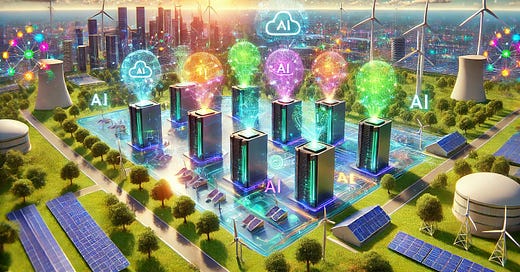How Data Centers Are Revolutionizing Sustainability In The Age Of AI
Imagine a city that never sleeps — pulsing with energy 24/7 — with millions of people and tens of thousands of businesses. Now, picture this city running entirely on clean energy. This isn’t science fiction; it’s the future driven by data centers, the hidden powerhouses driving our digital world. As the demand for computing power skyrockets — driven by technologies such as AI, robotics and autonomous vehicles — so does our environmental footprint. The tech industry now faces a pivotal challenge: How do we feed our insatiable appetite for computing power while ensuring a sustainable future for our planet?
In this article, I’ll explore how data centers are not just adapting to the sustainability challenge but also how they are leading the charge in creating a greener, more efficient future for all of us.
The Imperative For Sustainable Data Centers
From a technical standpoint, the exponential growth of AI and high-performance computing presents unique challenges. According to Goldman Sachs, data center power use is on the rise worldwide. The impact is already visible in key markets. For instance, in Virginia, a hub for U.S. data centers, commercial power consumption rose by 37% from 2016 to 2023. This dramatic increase in energy demand underscores the urgent need for innovative and energy-efficient technologies in data centers.
This surge in power consumption is not just a technical challenge; it’s reshaping the energy market landscape. Goldman Sachs notes that hedge funds and asset managers are increasingly interested in power derivatives, seeing opportunities in the AI-driven boom. The cost of power on the U.S. East Coast has been rising since early 2024, with the spark spread increasing by roughly 50% this year and nearly doubling over the past two years. These market shifts highlight the growing economic implications of data center energy consumption and the potential for innovative solutions in power generation and management.
Faced with these challenges, the tech industry is responding with groundbreaking innovations in data center designs and operations.
Here are some key areas where significant progress is being made:
Energy Efficiency Innovations
Advanced cooling technologies are at the forefront of energy efficiency efforts. Liquid cooling systems, once reserved for supercomputers, are becoming mainstream in data centers. These systems can reduce cooling energy consumption by over 18% compared to traditional air cooling methods. Companies like Google and Microsoft are utilizing these technologies, implementing liquid cooling in their data centers to handle the heat generated by AI workloads more efficiently.
AI-driven thermal management is another game-changer. Machine learning algorithms can predict heat patterns and adjust cooling systems in real time, optimizing energy use while maintaining ideal operating temperatures. DeepMind, for instance, reduced Google’s data center cooling energy by 40% using AI-powered recommendations.
Renewable Energy Integration
The shift toward renewable energy in data centers is accelerating. Most data center operators have committed to 100% renewable energy goals by 2030. The digital infrastructure company where I am CEO is carbon-free.
Amazon has also emerged amongst the leaders in this space, announcing in July 2024 that it has already achieved its goalof powering its operations with 100% renewable energy, a full seven years ahead of its original 2030 target. The company has become the largest corporate purchaser of renewable energy in the world for four consecutive years, investing billions of dollars in more than 500 solar and wind projects globally. To provide perspective, these projects generate enough energy to power the equivalent of 7.6 million U.S. homes.
Intelligent Workload Management
Carbon-aware computing is emerging as a powerful tool for sustainability in cloud services. Google Cloud exemplifies this approach with its comprehensive suite of tools designed to help customers reduce their carbon footprint. By integrating sustainability considerations into its platform, Google Cloud enables customers to make informed choices that balance performance needs with environmental impact. This approach not only helps companies achieve their sustainability goals but also optimizes resource usage, potentially leading to cost savings.
The Future Of Data Center Sustainability
As we look to the future, there are three key developments poised to revolutionize data center sustainability that leaders in the tech industry should keep a close eye on:
1. Next-Generation Sustainable Cooling Technologies: Emerging technologies like two-phase immersion cooling, where servers are submerged in a dielectric fluid that boils to remove heat, promise to dramatically reduce cooling energy requirements. This technology could enable even higher-density computing while significantly lowering energy consumption.
2. AI-Optimized Energy Management Systems: The next generation of data center management will leverage AI not just for workload distribution but for holistic energy optimization. These systems could predict energy demand, integrate renewable sources and manage storage solutions in real time, maximizing efficiency and minimizing carbon footprint.
3. Integration Of Data Centers Into Smart Grid Systems: Future data centers could likely play a more active role in broader energy ecosystems. By integrating with smart grids, data centers could serve as energy storage facilities, helping to balance the grid during peak demand periods and storing excess renewable energy when demand is low.
Shaping The Future: The Road Ahead For Sustainable Data Centers
The path to truly sustainable data centers continues to have challenges ahead, but the stakes couldn’t be higher. As tech leaders, we have a responsibility to drive innovation in this critical area. The solutions we develop today will shape the environmental impact of the digital economy for decades to come.
To stay ahead of the curve, tech leaders should invest in research and development of energy-efficient technologies specific to high-performance computing and AI workloads, collaborate with energy providers and policymakers to accelerate the transition to 100% carbon-free energy sources and implement and continually refine carbon-aware computing practices across their operations.
By prioritizing sustainability and carbon-free energy in our data centers, we’re not just reducing our environmental impact — we’re building a more resilient, efficient and responsible digital infrastructure for the future. The revolution in data center sustainability is underway, and it’s up to us to lead the charge toward a greener, more sustainable digital economy.
This article was originally published in Forbes by Rahul Mewawalla. Rahul Mewawalla, a technology and business leader, is the CEO and President of Mawson Infrastructure Group (NASDAQ: MIGI), a publicly-traded digital infrastructure company in the artificial intelligence (AI), high-performance computing (HPC), and digital assets markets. He was previously at Yahoo, Nokia, and General Electric Company and has served as a business and technology leader across high-growth and transformative technology companies. He also served as Senior Advisor on Innovation to the San Francisco Mayor’s Office and Chair of the Venture Capital Task Force Committee on Services and Systems.






